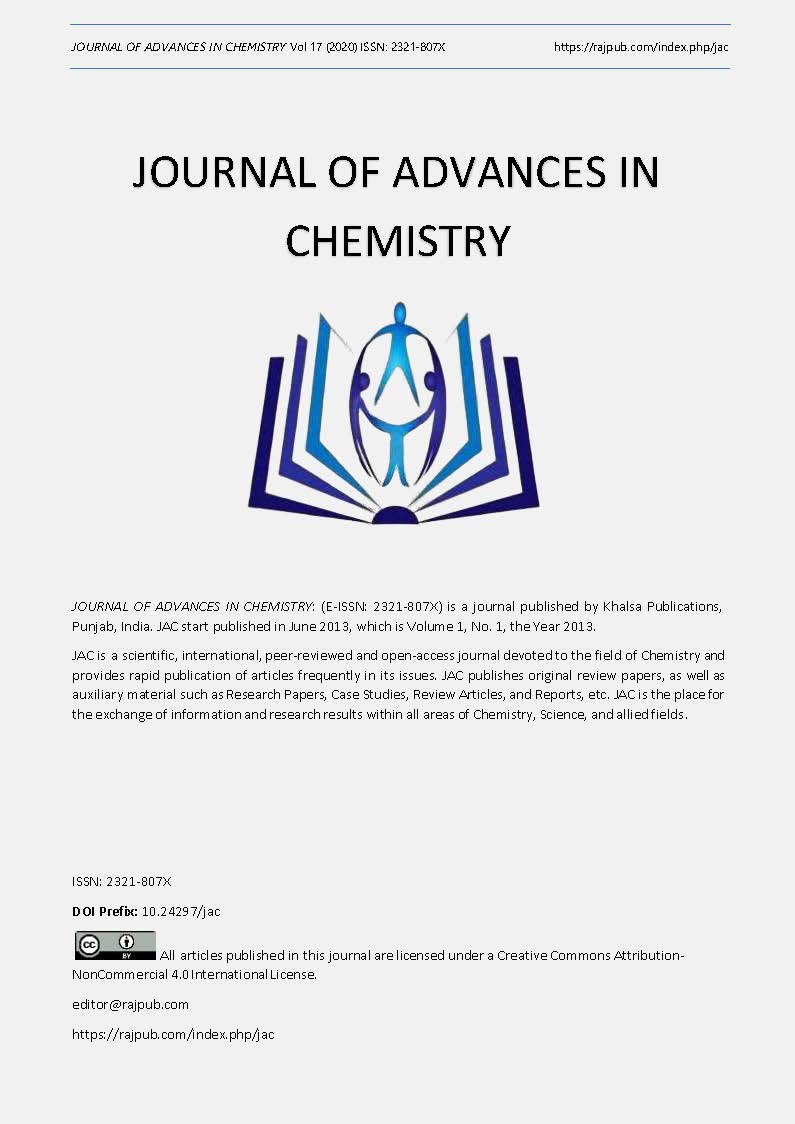Effect of Temperature Extraction on the Potassium and Calcium Content in the Lemon and Orange Water Peel Extracts
DOI:
https://doi.org/10.24297/jac.v17i.8714Keywords:
Water Extracts, Potassium, Calcium, Orange and Lemon PeelAbstract
The aim of this study is to examine the effect of temperature extraction on the potassium (K) and calcium (Ca) contents in orange and lemon peel extracts. The extractions were done at 62 ºC and 92 °C for 15 minutes and atmospheric pressure in distilled water. The fruit peel content in the extraction mixture was 5 % (w/v) in all samples. Calcium (Ca) and potassium (K) concentrations have been determined by flame photometric method. This research has revealed that by increasing the temperature of extraction, in particular, the concentration of Ca and K concentrations increased as applied extraction temperatures increased. The concentration of potassium is higher than the concentration of calcium in orange and lemon extracts, respectively. The concentration of K was 308 mg/l at 62 ºC and 361 mg/l at 92 ºC in lemon extracts, while in orange extracts the concentration of K was 476 mg/l at 62 ºC and 483 mg/l at 92 ºC. The concentration of Ca was 70.8 mg/l at 62 ºC and 71.9 mg/l at 92 ºC in lemon extracts, while in orange extracts the concentration of Ca was 91 mg/l at 62 ºC and 93.6 mg/l at 92 ºC. These results confirm that both citrus could be a very valuable source of potassium and calcium which are needed micronutrients to ensure the water and electrolyte balance and to build and maintain strong bones, proper function of muscles and nerves.
Downloads
References
Baghurst, Katrine & CSIRO. Health Sciences and Nutrition & Horticulture Australia (2003). Update of citrus health benefits literature review. Horticulture Australia, Sydney
Beto, J.A. (2015). The role of calcium in human aging. Clinical Nutrition Research. 4, 1-8. https://doi.org/10.7762/cnr.2015.4.1.1
Braddock R.J., Handbook of citrus by-products and processing technology (1999). Inc New York; John Wiley & Sons: 1-247
Bratovcic, A. (2020). Antioxidant Enzymes and their Role in Preventing Cell Damage. Acta Scientifci Nutritional Health, 4(3), 01–07. https://doi.org/10.31080/asnh.2020.04.0659
Bratovcic, A., & Suljagic, J. (2019). Micro- and nano-encapsulation in food industry. Croatian Journal of Food Science and Technology, 11(1), 113–121. https://doi.org/10.17508/cjfst.2019.11.1.17
Bratovcic, A., Odobasic, A., Sestan, I., Tucic, E., Hasanbasic, A. & Saric, E. (2018). Determination of physical-chemical properties and stability of orange juice at room temperature, Sixth international scientific conference „June 5th – World environment day“, 76-88.
Czech, A., Zarycka, E., Yanovych, D., Zasadna, Z., Grzegorczyk, I., & Kłys, S. (2020). Mineral Content of the Pulp and Peel of Various Citrus Fruit Cultivars. Biological Trace Element Research. https://doi.org/10.1007/s12011-019-01727-1
Egnér, H., Riehm, H., & Domingo, W. R. (1960). Untersuchungen über die chemische Bodenanalyse als Grundlage für die Beurteilung des Nährstoffzustandes der Böden. II. Chemische Extraktionsmethoden zur Phosphor- und Kaliumbestimmung. Kungliga Lantbrukshögskolans Annaler.
European Commission, Closing loop—An EU action plan Circular Economy, Communication from the Commission to the European Parliament, the Council, the European Economic and Social Committee and the Committee of the Regions, C.O.M. 0614, 2015.; available on: https://eur-lex.europa.eu/legal-content/EN/TXT/?uri=CELEX%3A52015DC0614
Food and Agriculture Organization of the United Nations, available on 27.12.2019. http://www.fao.org/faostat/en/#data/QC
Jennings, K. A. (2018) Top 15 Calcium-Rich Foods (Many Are Non-Dairy). Healthline, available on 27.12.2019. https://www.healthline.com/nutrition/15-calcium-rich-foods
Liu, Y., Ahmad, H., Luo, Y., Gardiner, D.T., Gunasekera, R.S., McKeehan, W.L., & Patil, B.S. (2001). Citrus pectin: characterization and inhibitory effect on fibroblast growth factor-receptor interaction. Journal of Agricultural and Food Chemistry, 49, 3051–3057; https://doi.org/10.1021/jf001020n
Ma, E., Cervera, Q., & Mejía Sánchez, G. M. (1993). Integrated utilization of orange peel. Bioresource Technology. 44, 61-63. https://doi.org/10.1016/0960-8524(93)90209-T
Marín, F. R., Soler-Rivas, C., Benavente-García, O., Castillo, J., & Pérez-Alvarez, J. A. (2007). By-products from different citrus processes as a source of customized functional fibres. Food Chemistry. 100, 736-741. https://doi.org/10.1016/j.foodchem.2005.04.040
Miggiano G.A., & Gagliardi L., (2005) Diet, nutrition and bone health. La Clinica Terapeutica. 156, 47-56. Available on: https://www.ncbi.nlm.nih.gov/pubmed/16080661
NutritionValue.Org, Nutrition facts Product: Orange peel raw, available on 27.12.2019. https://www.nutritionvalue.org/Orange_peel%2C_raw_nutritional_value.html
Okwi, D.E & Emenike, I.N. (2006). Evaluation of the phytonutrients and vitamins contents of citrus fruits. Int. J. Mol. Med. Adv. Sci. 2, 1-6; available on: https://medwelljournals.com/abstract/?doi=ijmmas.2006.1.6
Otten, J. J., Hellwig, J. P., & Meyers, L. D. (2006). Part III: Vitamins and Minerals: Thiamin Dietary Reference Intakes. In Dietary Reference Intakes: The Essential Guide to Nutrient Requirements. https://doi.org/10.17226/11537
Pohl, H. R., Wheeler, J. S., & Murray, H. E. (2013). Sodium and Potassium in Health and Disease. https://doi.org/10.1007/978-94-007-7500-8_2
Salunkhe D.K., & Kadam S.S. (1995). Handbook of fruit science and technology. Production, composition, storage and processing. CRC press; 1-632. Available on: https://www.routledge.com/Handbook-of-Fruit-Science-and-Technology-Production-Composition-Storage/Salunkhe-Kadam/p/book/9780824796433
Santos, C. M., Dweck, J., Viotto, R. S., Rosa, A. H., & de Morais, L. C. (2015). Application of orange peel waste in the production of solid biofuels and biosorbents. Bioresource Technology. 196, 469-479. https://doi.org/10.1016/j.biortech.2015.07.114
Sharma, K., Mahato, N., Cho, M. H., & Lee, Y. R. (2017). Converting citrus wastes into value-added products: Economic and environmently friendly approaches. Nutrition. 34, 29-46. https://doi.org/10.1016/j.nut.2016.09.006
Stone, M. S., Martyn, L., & Weaver, C. M. (2016). Potassium intake, bioavailability, hypertension, and glucose control. Nutrients. 8, 444. https://doi.org/10.3390/nu8070444
Torrado, A. M., Cortés, S., Salgado, J. M., Max, B., Rodríguez, N., Bibbins, B. P., … Domínguez, J. M. (2011). Citric acid production from orange peel wastes by solid-state fermentation. Brazilian Journal of Microbiology. 42, 394-409. https://doi.org/10.1590/S1517-83822011000100049
Unger N., & Razza F. (2018) Food Waste Management (Sector) in a Circular Economy. In Benetto, E., Gericke K., Guiton M. (eds.), Designing Sustainable Technologies, Products and Policies. Springer, Cham. 127-132, https://doi.org/10.1007/978-3-319-66981-6_15
Downloads
Published
How to Cite
Issue
Section
License
 All articles published in Journal of Advances in Linguistics are licensed under a Creative Commons Attribution 4.0 International License.
All articles published in Journal of Advances in Linguistics are licensed under a Creative Commons Attribution 4.0 International License.




